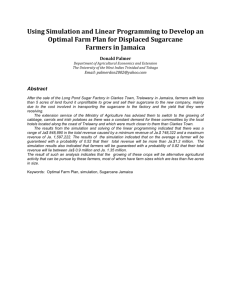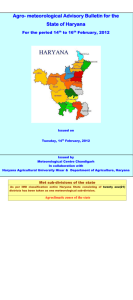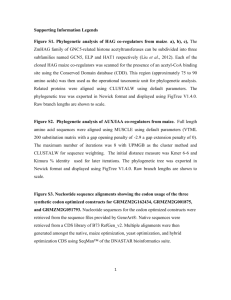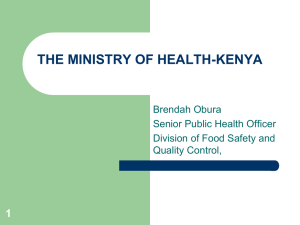electronic supplementary material LCA for renewable resources Life
advertisement
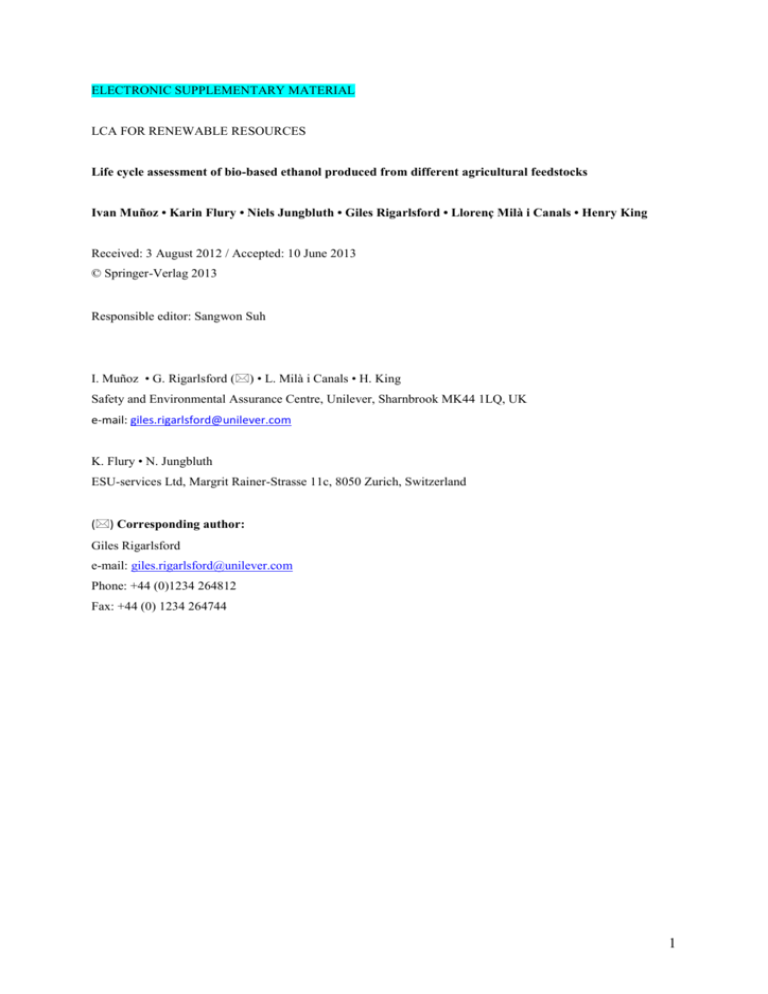
ELECTRONIC SUPPLEMENTARY MATERIAL LCA FOR RENEWABLE RESOURCES Life cycle assessment of bio-based ethanol produced from different agricultural feedstocks Ivan Muñoz • Karin Flury • Niels Jungbluth • Giles Rigarlsford • Llorenç Milà i Canals • Henry King Received: 3 August 2012 / Accepted: 10 June 2013 © Springer-Verlag 2013 Responsible editor: Sangwon Suh I. Muñoz • G. Rigarlsford () • L. Milà i Canals • H. King Safety and Environmental Assurance Centre, Unilever, Sharnbrook MK44 1LQ, UK e-mail: giles.rigarlsford@unilever.com K. Flury • N. Jungbluth ESU-services Ltd, Margrit Rainer-Strasse 11c, 8050 Zurich, Switzerland () Corresponding author: Giles Rigarlsford e-mail: giles.rigarlsford@unilever.com Phone: +44 (0)1234 264812 Fax: +44 (0) 1234 264744 1 Global warming potential (from cradle to grave) 3.0 kg CO2-eq/kg 2.5 2.0 1.5 1.0 0.5 0.0 Sugarcane, BR CS Sugarcane, BR NE Maize grain, US Base case Maize stover, US Sugar beet, FR Wheat, FR Sugar beet, FR Wheat, FR Sugar beet, FR Wheat, FR Sugar beet, FR Wheat, FR Sugar beet, FR Wheat, FR Sugar beet, FR Wheat, FR 100% allocated to ethanol Freshwater eutrophication potential 0.0005 kg P-eq/kg 0.0004 0.0003 0.0002 0.0001 0.0000 Sugarcane, BR CS Sugarcane, BR NE Maize grain, US Base case Maize stover, US 100% allocated to ethanol Marine eutrophication potential 0.030 kg N-eq/kg 0.025 0.020 0.015 0.010 0.005 0.000 Sugarcane, BR CS Sugarcane, BR NE Maize grain, US Base case Maize stover, US 100% allocated to ethanol Terrestrial acidification potential 0.030 kg SO2-eq/kg 0.025 0.020 0.015 0.010 0.005 0.000 Sugarcane, BR CS Sugarcane, BR NE Maize grain, US Base case Maize stover, US 100% allocated to ethanol Photochemical oxidant formation potential kg NMVOC/kg 0.07 0.06 0.05 0.04 0.03 0.02 0.01 0.00 Sugarcane, BR CS Sugarcane, BR NE Maize grain, US Base case Maize stover, US 100% allocated to ethanol Agricultural land occupation m2a/kg 7 6 5 4 3 2 1 0 Sugarcane, BR CS Sugarcane, BR NE Maize grain, US Base case Maize stover, US 100% allocated to ethanol Fig. 1 Results of the sensitivity analysis on allocation. 100 % of environmental burdens allocated to ethanol, 0 % to co-products 2 Global warming potential (from cradle to grave) kg CO2-eq/kg 2.5 2.0 1.5 1.0 0.5 0.0 Sugarcane, BR CS Sugarcane, BR NE Maize grain, US Basic assumptions Maize stover, US Sugar beet, FR Wheat, FR No pre-harvest burning Freshwater eutrophication potential 0.0005 kg P-eq/kg 0.0004 0.0003 0.0002 0.0001 0.0000 Sugarcane, BR CS Sugarcane, BR NE Maize grain, US Basic assumptions Maize stover, US Sugar beet, FR Wheat, FR No pre-harvest burning Marine eutrophication potential kg N-eq/kg 0.020 0.015 0.010 0.005 0.000 Sugarcane, BR CS Sugarcane, BR NE Maize grain, US Basic assumptions Maize stover, US Sugar beet, FR Wheat, FR Sugar beet, FR Wheat, FR Sugar beet, FR Wheat, FR Sugar beet, FR Wheat, FR No pre-harvest burning Terrestrial acidification potential kg SO2-eq/kg 0.020 0.015 0.010 0.005 0.000 Sugarcane, BR CS Sugarcane, BR NE Maize grain, US Basic assumptions Maize stover, US No pre-harvest burning kg NMVOC/kg Photochemical oxidant formation potential 0.035 0.030 0.025 0.020 0.015 0.010 0.005 0.000 Sugarcane, BR CS Sugarcane, BR NE Maize grain, US Basic assumptions Maize stover, US No pre-harvest burning Agricultural land occupation m2a/kg 4 3 3 2 2 1 1 0 Sugarcane, BR CS Sugarcane, BR NE Maize grain, US Base case Maize stover, US No pre-harvest burning Fig. 2 Results of the sensitivity analysis on pre-harvest burning of sugarcane. In the base case 70 % of the biomass is burnt, and none in the ‘no pre-harvest burning’ scenario 3 Global warming potential (from cradle to grave) kg CO2-eq/kg 2.5 2.0 1.5 1.0 0.5 0.0 Sugarcane, BR CS Sugarcane, BR NE Maize grain, US Climate change Maize stover, US Sugar beet, FR Wheat, FR Sugar beet, FR Wheat, FR Sugar beet, FR Wheat, FR Sugar beet, FR Wheat, FR Sugar beet, FR Wheat, FR Sugar beet, FR Wheat, FR Maize grain drying Freshwater eutrophication potential 0.0005 kg P-eq/kg 0.0004 0.0003 0.0002 0.0001 0.0000 Sugarcane, BR CS Sugarcane, BR NE Maize grain, US Base case Maize stover, US Maize grain drying Marine eutrophication potential kg N-eq/kg 0.020 0.015 0.010 0.005 0.000 Sugarcane, BR CS Sugarcane, BR NE Maize grain, US Base case Maize stover, US Maize grain drying Terrestrial acidification potential kg SO2-eq/kg 0.020 0.015 0.010 0.005 0.000 Sugarcane, BR CS Sugarcane, BR NE Maize grain, US Base case Maize stover, US Maize grain drying Photochemical oxidant formation potential kg NMVOC/kg 0.04 0.03 0.03 0.02 0.02 0.01 0.01 0.00 Sugarcane, BR CS Sugarcane, BR NE Maize grain, US Base case Maize stover, US Maize grain drying m2a/kg Agricultural land occupation 4 3 3 2 2 1 1 0 Sugarcane, BR CS Sugarcane, BR NE Maize grain, US Base case Maize stover, US Maize grain drying Fig. 3 Results of the sensitivity analysis on maize grain drying 4 Global warming potential (from cradle to grave) 6 5 kg CO2 -eq/kg 4 3 2 1 0 Sugarcane, BR CS Sugarcane, BR NE Maize grain, US Maize stover, US Sugar beet, FR Wheat, FR Fossil, RER kg P-eq/kg Freshwater eutrophication potential 1.0E-03 9.0E-04 8.0E-04 7.0E-04 6.0E-04 5.0E-04 4.0E-04 3.0E-04 2.0E-04 1.0E-04 0.0E+00 Sugarcane, BR CS Sugarcane, BR Maize grain, US NE Maize stover, US Sugar beet, FR Wheat, FR Fossil, RER Wheat, FR Fossil, RER Photochemical oxidant formation potential 0.06 kg NMVOC-eq/kg 0.05 0.04 0.03 0.02 0.01 0.00 Sugarcane, BR CS Sugarcane, BR NE Maize grain, US Maize stover, US Sugar beet, FR Marine eutrophication potential 0.06 0.05 kg N-eq/kg 0.04 0.03 0.02 0.01 0.00 Sugarcane, BR CS Sugarcane, BR Maize grain, US Maize stover, US Sugar beet, FR NE Wheat, FR Fossil, RER Terrestrial acidification potential 2.5E-02 kg SO2 -eq/kg 2.0E-02 1.5E-02 1.0E-02 5.0E-03 0.0E+00 Sugarcane, BR CS Sugarcane, BR Maize grain, US NE Maize stover, US Sugar beet, FR Wheat, FR Fossil, RER Wheat, FR Fossil, RER Agricultural land occupation 4.5 4.0 m 2 yr/kg 3.5 3.0 2.5 2.0 1.5 1.0 0.5 0.0 Sugarcane, BR CS Sugarcane, BR NE Maize grain, US Maize stover, US Sugar beet, FR Fig. 5 Results of probabilistic analysis for ReCiPe impact indicators 5 The excel file below summarizes the estimation of the amount of LUC attributed to each crop in the last 20 years according to the method by Milà i Canals et al. (2012): LUC estimates for crops.xlsx Sugarcane in Brazil (North-East and Centre-South): 0.032 Ha/Ha Wheat in France: 0.016 Ha/Ha The calculation of GHG emissions resulting from LUC is carried out with the tool developed by Flynn et al. (2012). Table 1 provides an overview of the input data used for each crop. Table 1 Parameter set applied in the model of Flynn et al. (2012) to determine the greenhouse gas emissions from land use changes Soil C Calculations & maps Native C stock Categories Parameters Brazil CentreSouth Climate zone Tropical moist Soil types Low Activity Clay New C stock* Biomass C Warm temperate dry Wetland 91%Temperate/bore al, 4.5% temperate/boreal dry, 4.5% temperate/boreal moist 91% native / managed grassland, 9% annual crops 91%Improved, 9% Reduced tillage, low inputs 50% temp/boreal dry, 50% temperate/boreal moist Annual crop All All Land use native / managed forest native / managed forest Management & inputs sustainable or none sustainable or none Climate zone Tropical wet/moist Tropical wet/moist & tropical dry Land use Perennial crops Full tillage, medium inputs Perennial crops Full tillage, medium inputs Climate region Tropical Tropical location N & S America Former land use/veg Tropical moist forest (>30%) Crop type Sugarcane N & S America Tropical moist forest (>30%) & tropical dry forest (>30%) Sugarcane Climate zone Tropical moist Tropical moist All Region/country Central & S America Central & S America - Management & inputs Previous biomass C stock Parameters France Climate zone Previous LU stock factor New LU stock factor Parameters Brazil North-East Tropical moist & tropical dry Low Activity Clay Reduced tillage, low inputs 50% warm temperate dry, 50% warm temperate moist/wet All Grassland Annual crops The excel files below show the specific calculations for each crop using this tool: GHG from LUC Wheat.xls GHG from LUC Centre-South.xls GHG from LUC Sugarcane Sugarcane North-East.xls 6 The GHG emissions calculated in these spreadsheets correspond to land 100% changed. In order to get the emissions averaged over the LUC happened in the last 20 years in the corresponding countries we need to take into account the amounts of LUC previously estimated. As an example, for wheat the emissions per unit of occupied land (ha ·year) are: 4711 kg CO2-eq/ha-LUC/year x 0.016 ha-LUC/ha = 75.4 kg CO2-eq/ha/year Using the yield of ethanol per ha and year for each crop, the GHG emissions per kg ethanol can be obtained. It must be highlighted that in the above calculation the amount of LUC has not been annualized with a 20 year-period. This is because the GHG result from the tool by Flynn et al. (2012) already provides an emission annualized by 20 years, thus dividing again would be double-counting. However, in order to determine the amount of LUC per kg ethanol a division by 20 years is needed. 7




